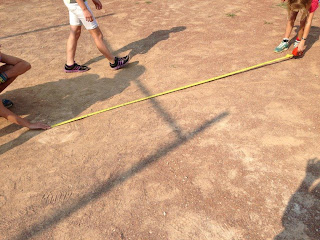One of the activities I started our year with was "Solve It Your Way". I read about Solve It Your Way this summer on one of my favorite blogs, A Year of Reading. The premise behind this project is that kids are given a question...and that's about it. We give kids time to think, ponder, chat, discover, and reflect on the question. Then they try some experiments. Then they come back together and talk about what worked and what didn't.
I thought this fit in perfectly with our "theme" for the year. Here's how my classroom approached Solve It Your Way:
Since it was the first week of school, I thought this would be a great project for me to observe how kids worked together and what they knew about putting together projects and experiments. I put my kids into 5 random groups. I put the question up on the board: Which Type of Ball Can Roll The Farthest?
I gave groups several minutes to chat. Then we came back together and we looked at the Questions to Ask Yourself part of the website. From that point on, groups had time to brainstorm and plan. Here are some of our brainstorming charts:
The next day, the kids came prepared to experiment. I never imagined the sheer volume of balls that would enter my classroom. Everything from the smallest marble to a plethora of bouncy balls to baseballs to water polo balls to soccer balls to basketballs to an enormous pink I don't even know what kind of ball.
We went out on the playground armed with yardsticks, tape measures, clipboards, and of course all of our balls. Right away, it was interesting to see where each group gravitated. Most groups wanted flat ground. Several groups were interested in how the balls would roll on different terrain: grass, mulch, dirt. Despite our discussion about how one of our challenges would be pushing each ball with the same amount of force, only one group decided to use a ramp (the twisty slide on the playground).
The kids spent about 45 minutes experimenting and gathering data.
After our experiments, we went back inside and debriefed. We talked about how scientists use their data and results to draw conclusions. We also talked about how scientists reflect and think about what they would change the next time they tried an experiment. The kids made some posters about their process, results and conclusions.
This was such a fun project. We are looking forward to spending time each month Solving It Our Way!










Welcome to the slicing world! I bet your kids were so excited to learn that this year they would have opportunities to solve challenges. What a great way to develop community right away.
ReplyDeleteMs. Williams' class. It sure looked like you had a wonderful time being scientists! I loved the charts and tables you created from the data you collected. I hope you try the next challenge. Our class was impressed with the work you did.
ReplyDeleteThanks for sharing!
Mr. Peterson's class.